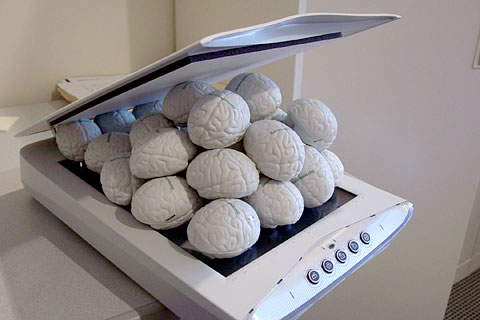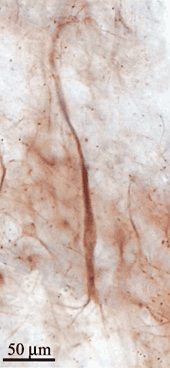Liberal vs Conservative Brains (ugh)
Last week I managed to get mixed up in a huge debate on Slate.com regarding the recent Amodio, Jost, Master, and Yee paper in Nature Neuroscience. The paper was a brief report on the ‘Neurocognitive correlates of liberalism and conservatism’ where the authors reported that liberals possessed a greater error-related negativity (ERN) wave during a Go/NoGo task. What erupted after its publication was a partisan firestorm.
I panned the article at first since it was so far outside of my core interests. The paper also combined a two topics I consider questionable: ERP source localization and political social neuroscience. Still, a few days later while reading Slate I ran across a response piece posted by William Saletan, entitled “Rigging a study to make conservatives look stupid“. At once I was struck by how terribly argued the response was and how far from scientific truth his conclusions were. I was compelled to enter ‘The Fray’ and engage the debate as a neuroscientist. See my original post with subsequent responses here.
I don’t want to reignite the liberal vs conservative debate again in this forum. Judging from the Slate message boards I think the topic has been given more than enough attention. However, I did want to note how misinterpreted the Amodio et al. results were. I am not a huge fan of the paper – I have various issues with both their method and the discussion of results. Still, seeing headlines like “Liberals smarter than conservatives” and “Rigging a study to make conservatives look stupid” was not their fault. They are simply terrible examples of how mass media can take things to far.
The whole situation is very frustrating, but there are lessons we can take away from it. I think what I am focusing on is the importance of public dissemination of research by the experts themselves. I try to do this through presentations on the developing brain for parents and children. It is one of the favorite parts about my job, and something I take very seriously. Without a third party between my words and their ears I feel that I can more accurately represent the science behind development. I think that this, in some small way, will help to balance out the terrible misinterpretations by popular media. One can hope anyway…
This is a brain scanner

Don’t even think of asking if the brains ‘light up’…
Brain Camp Review – Von Economo Neurons

While at UCLA we had the pleasure of a lecture by Dr. John Allman of Caltech. Dr. Allman is a worldwide leader in the investigation of Von Economo neurons (VEN) or ‘spindle’ cells. While he was originally slated to give an introductory neuroanatomy lecture, he ended up spending much of the time discussing this very unique cell type.
Von Economo neurons are large bipolar cells that are found in cortical layer V of the anterior cingulate and fronto-insular regions. The cells have also been found in the gray matter of the ventral claustrum, near the amygdala. Originally discovered by Von Economo and Koskinas (1925) the cells are much larger [5x] than comparable layer V pyramidal cells. The size of these cells seems to indicate that they stand ready to send signals very quickly across long distances.
Von Economo cells are not ubiquitous across animal brains. Only humans, great apes, certain whales, and elephants have been shown to possess VENs. The relative number of cells varies by species, with humans having by far the greatest amount – over twice the number of our nearest evolutionary neighbor. One argument is that some aspect of VEN function is giving rise to the cognitive abilities that make us uniquely human.
Of interest developmentally is that not all Von Economo neurons are in place when we are born. Only 15% of the cells seem to be in place at birth. It takes several additional years for the number of cells to rise to adult-like levels. It is unknown if existing cell types are morphing into Von Economo neurons or if new neurons are migrating into place during this time. In either case, VEN development in somewhat protracted compared to other cell types.
In terms of pathology VENs seem to be particularly vulnerable to certain types of disease. In a paper by Seeley et al. (2006) they found that early fromtotemporal dementia resulted in a 74% loss of Von Economo neurons throughout the cingulate and insula. VENs that remained were dysmorphic and plagued with tau protein accumulation. Other neuron types were unaffected and a control group of Alzheimers patients did not show the same pattern of VEN loss.
What remains unknown is where the Von Economo neurons project to and what function(s) they support. Everybody likes to do some hand-waving in this regard. Some argue that VENs are projecting to frontopolar cortex, while others believe that VENs in the cingulate and insula are reciprocally connected. This anatomical uncertainty hasn’t stopped scientists from hypothesizing that these cells may (or may not) be linked to high-speed intuitive decision making and possibly higher-order social cognition. From my perspective there is still little support for this case and extrapolating region-level fMRI results to the function of a single cell type is going too far.
In summary I find Von Economo neurons very fascinating. Part of what draws me to cognitive neuroscience is the philosophical investigation into what processes make humans so unique compared to other animals. I do believe that the VENs are one part of this greater puzzle. I also want to believe that VENs play a role in intuitive thought and higher-order processes. However, I fear it will be some time before scientists are able to adequately demonstrate that link.
—-
References and further reading:
The Allman Lab website
Allman JM, Hakeem AY, and Watson KK. (2002) “Two Phylogenetic Specializations in the Human Brain.” The Neuroscientist, 8(4): 35-346.
Allman JM, Watson KK, Tetreault NA, and Hakeen AY. (2005). “Intuition and autism: a possible role for Von Economo neurons.” Trends in Cognitive Sciences. 9(8): 367-373.
Seeley WW, Carlin DA, Allman JM, Macedo MN, Bush C, Miller BL, Dearmond SJ. (2006). “Early frontotemporal dementia targets neurons unique to apes and humans.” Annals of Neurology. 60(6): 660-667.
Von Economo C, and Koskinas. (1925). “Die Cytoarchtectonik der Hirnrinde des erwachsenen Menschen.”
Quote of the Week – Hertz
One cannot escape the feeling that these mathematical formulas have an independent existence and an intelligence of their own, that they are wiser than we are, wiser even than their discoverers, that we get more out of them than was originally put into them. – Heinrich Hertz
Advanced Neuroimaging Summer School Wrapup
I have just returned from the UCLA Advanced Neuroimaging Summer School and, seriously, it was one of the best things I have done in graduate school. The funny part is that it wasn’t the classes or the labs that really made the course great, it was the people. From the informal imaging discussions over dinner in the dorm to talking MR physics with Mark Cohen over a beer at the Westwood Brewery – the other scientists attending the program were what mattered most.
One Brain-Camper noted that on the wall in his advisor’s office was a picture from a similar summer camp in the early 80s. He said that you can look at the faces now and recognize them as some of the biggest names and leaders in our field. I think there was the silent hope that many of us were moving in that same direction. In 25 years we will have to check in and see how well we did.
I am just now beginning to pour over the pages and pages of notes from the last 14 days. I was thinking of putting a list of highlights into this post, but I don’t believe that it would do the program (or the speakers) justice. Time permitting I will put up subject-specific posts focusing on one topic at a time.
As a wrapup I just want to thank Russ Poldrack, Mark Cohen, and Susan Bookheimer for organizing the summer course. They did an incredible job putting this course together for the first time. Thanks are also due to the many excellent speakers who took time out of their lives to come and instruct us on the nuances of neuroimaging. Finally, thanks to the NIH for funding such a great program. I am confident that the next several years will demonstrate that this was money well spent.
Quote of the Week – James
“The fluctuations of the blood-supply to the brain were independent of respiratory changes, and followed the quickening of mental activity almost immediately. We must suppose a very delicate adjustment whereby the circulation follows the needs of cerebral activity. Blood very likely may rush to each region of the cortex according as it is most active, but of this we know nothing.” – William James, Principles of Psychology, 1890
In Los Angeles
I am out at UCLA for the next two weeks attending the Advanced Neuroimaging Summer Program. It is amazing to be here because I have always seen UCLA and the Laboratory of Neuroimaging as a great center of neroscience globally.
We just wrapped up the first day and it was incredibly awesome – Mark Cohen’s talks on MR physics were great and I got to meet John Allman in person for the first time. I will try to put up some of my discussion notes in the next several days. It is tough to be away in the middle of the dissertation, but I think it will be worth every minute to learn from the masters.
Quote of the Week – Asimov
“The most exciting phrase to hear in science, the one that heralds new discoveries, is not ‘Eureka!’ but rather ‘That’s funny’…” – Isaac Asimov
When magnets attack
When I was a kid we used to buy dry ice from the local supermarket. We would take it home and drop a few ounces of the stuff into sealed two-liter bottles. Over the course of fifteen minutes the dry ice would sublime to carbon dioxide gas, causing the bottle to distend and eventually burst. Let me rephrase that – it would cause the bottle to distend and eventually explode.
Something like that happened to this MR scanner, only it involved liquid helium and was a lot more dangerous. Holy schnikes…
Comments are open
If you feel compelled to comment on a post you may now do so. The first comment you submit to the weblog will be moderated, but subsequent posts will go straight through. On my previous site comment spam was a real problem, but we have installed some fantastic anti-spam plugins that I hope will keep the wheat and chaff separate. Enjoy!
